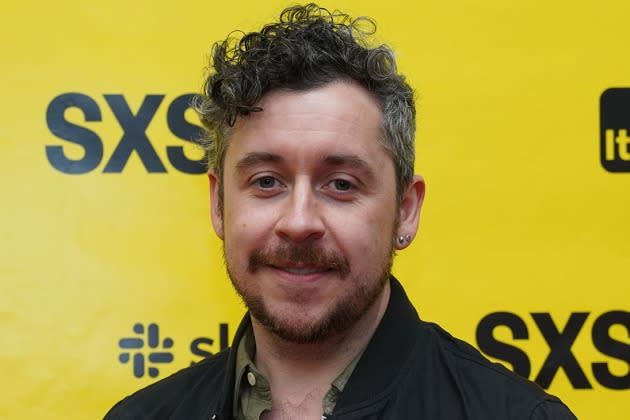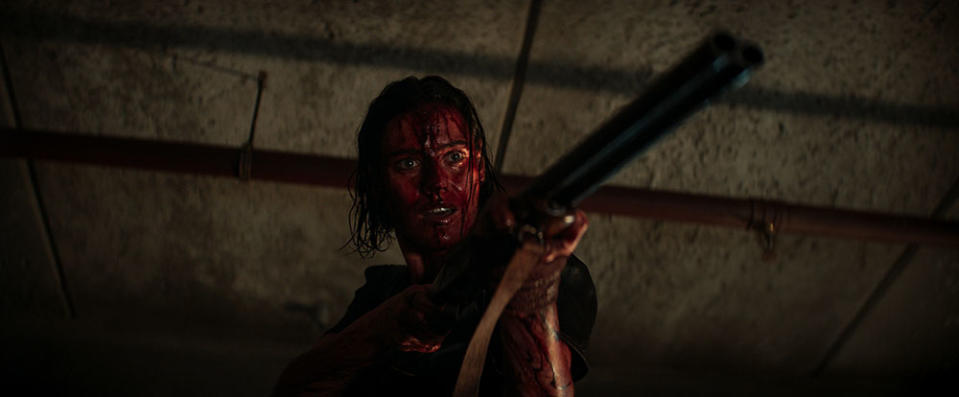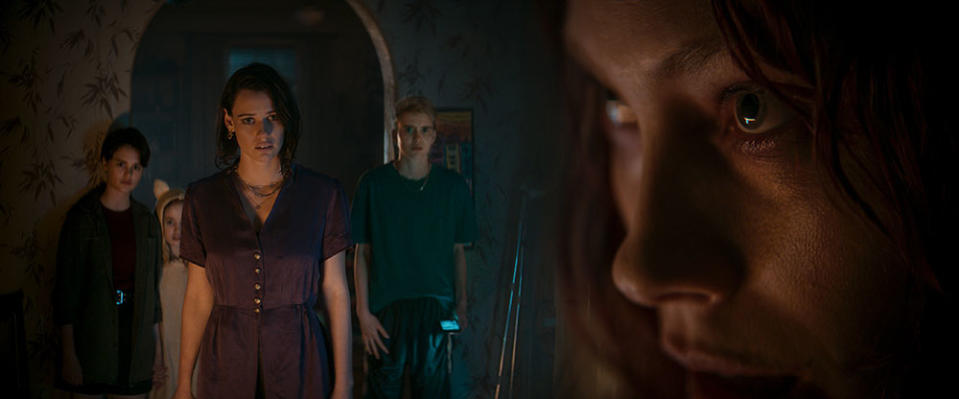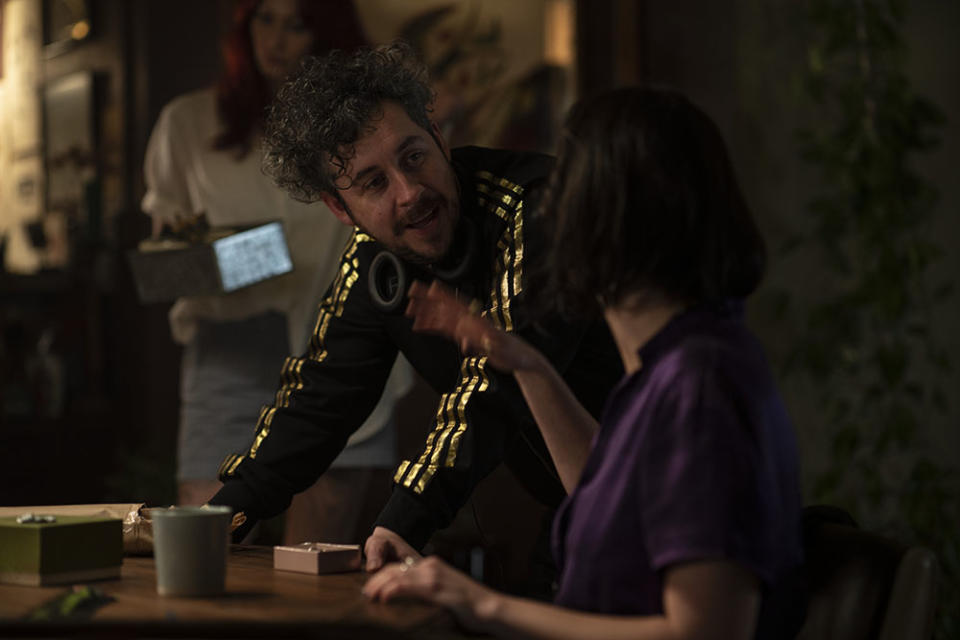How ‘Evil Dead Rise’ Filmmaker Lee Cronin Made the Franchise’s Most Successful Entry

Evil Dead Rise filmmaker Lee Cronin credits the franchise’s brain trust of Sam Raimi and Bruce Campbell for the resounding success of his latest film. The Irish filmmaker recognized that the franchise needed to take another left turn, similar to what Raimi did with the more heightened and fantastical third chapter, Army of Darkness (1992). So instead of another cabin-in-the-woods story, Cronin took Rise to a condemned Los Angeles apartment building, as an artistic single-parent family has to now deal with the Book of the Dead’s wrath.
Raimi and Campbell quickly blessed Cronin’s manner of subversion, and what resulted was the highest-grossing Evil Dead film to date, totaling $146 million on a $19 million spend.
More from The Hollywood Reporter
Terra Potts Exits Movie Marketing Post at Warner Bros. (Exclusive)
Box Office: 'Super Mario' Hits $872M Globally, 'Evil Dead Rise' Opens to Big $23.5M in U.S.
Nell Fisher, Michael Smiley Join Elijah Wood in 'Bookworm' (Exclusive)
“They gave me the freedom to go and perform, because they’ve been through the ringer over the years,” Cronin tells The Hollywood Reporter. “They started out in the most independent way possible, and they worked their way through the machine. So they know that the best results are achieved by actually backing the person that you have hired to go and do the job, and I never really felt like I had to look over my shoulder a whole lot.”
With his newly acquired cachet, Cronin is certainly open to making a follow-up to Rise, but he seems more interested in exploring one of his original ideas.
“There is a part of me that’s interested in planting a very different flag within genre … Maybe it would be gratifying for me to just go and do something else,” Cronin says. “I put down other original ideas and original screenplays to go and make Evil Dead Rise. So it’s nice to be in this moment where I’m able to look around and think about what’s next.”
Below, during a recent chat with THR, Cronin also details the sequence that involved over 1,700 gallons of fake blood, as well as how he managed to avoid an NC-17 rating on the feature, which hit theaters in April and is now on 4K.
So I know you worked with Sam Raimi on a series before Evil Dead Rise, but knowing that you were making an Evil Dead movie with the franchise architects as EPs, were you constantly on edge and looking over your shoulder? I’m sure I’m projecting a bit.
(Laughs.) It’s a little bit of projection, but it’s a reasonable question. It might not always work this way, but thankfully, it was a great meeting in terms of me wanting to make a different movie to my first movie [The Hole in the Ground] and those guys wanting to reignite the franchise in a way that hadn’t been done before. So I would like to think that I’m a strong pitcher and communicator in terms of getting across what it is that I want to do, and once the process moved along and it turned into a screenplay, the guys understood my vision for the movie. They gave me the freedom to go and perform, because they’ve been through the ringer over the years. They started out in the most independent way possible, and they worked their way through the machine. So they know that the best results are achieved by actually backing the person that you have hired to go and do the job, and from that point of view, I never really felt like I had to look over my shoulder a whole lot.
When you eventually screened the movie for Raimi and Bruce Campbell, did you pace back and forth outside the screening room for 90 minutes?
Because we were living in a COVID time, I was not actually there with the guys, so I would’ve sent my director’s cut to them and they would’ve watched it in the U.S. [Producer] Rob Tapert would’ve watched it in New Zealand, where he’s based, and I would’ve just been in a different time zone in Ireland. I’d been working so hard in post, and so I was probably fast asleep when they were watching it at that point in time. But thankfully, the movie was delivering on its promise, and everybody felt like it was in a really good place. We then knuckled down and started to tighten the screws on it.

What was the thought process behind the framing device? Did you want people to think they were getting another “cabin” story only to take a left turn?
Yeah, I did. First of all, I wanted to have a cold open that gave people a taste of what was to come. I quite enjoy that in movies, I quite enjoy it in horror movies and I quite enjoy it when I write. It’s this idea of giving people a starter before the main course kicks in, and so I knew I wanted to do that. But then I started to come up with these slightly subversive ideas where I could give you a taste of what was familiar, but then take that hard turn. So it just felt like a really fun thing to do. Also, in practical terms, I knew this film was going to be very contained and quite claustrophobic, and so I wanted an opportunity to open up the world as well.
As a fan and as a movie nerd, I was like, “I’m making an Evil Dead film. I still want to be able to go to a cabin in the woods for a few minutes, even though the story that I’m telling is in a very different context and that context better suits the story I want to tell.” So I wrote that opening very early on, and while I would never usually share part of a screenplay, I just sent it to the guys [Raimi and Campbell]. And it worked! They were like, “OK, we know the movie that we’re in,” because it had the tone, the atmosphere and the type of ideas in play. And on we went from there. We meet the family, and all hell breaks loose.
Did they appreciate the drone gag, since it plays with the visual language of the franchise?
Yeah, absolutely. It was just an idea that popped into my head, and I was like, “Wouldn’t it be really cool to just open the movie with one of the most iconic visual aspects of Evil Dead? We hear a sound, we hear a noise, something’s coming and bang, we’re in.” So I knew I wanted to do that, and then I thought, “Well, I should subvert that idea. For fans of the franchise, it will allow them to know that they’re in safe hands, because I understand what it’s about. I’m also going to turn some things on their head and offer up ideas that play out in different ways.”

So how close were you to not getting an R-rating?
It was never in doubt, actually. I feel like we maybe had to trim a couple of seconds, but that was it. So it was never, “You’re NC-17 and you’ve got to do all these things.” There were just one or two tiny notes, and a lot of people are surprised that it did get that rating so easily. There’s a strange heart to this movie, as well. Although it’s violent and crazy at times with a lot of blood and gore, there is a little bit of a playfulness to how that is onscreen. So it’s not grim or sinister in that way. I remember saying to Rob [Tapert] on set, “I’m going to stick the knife in, but I’m not gonna stay there forever while it twists around and around, cutting back to screams.” I just wanted the movie to have energy and momentum, and that probably helped the cause. I didn’t gaze at it for too long to make it feel uncomfortable.
I loved all the split diopter shots, and because directors, at least in my experience, seldom want to admit that they’re going for a cool shot, what were the guidelines for deploying one of these shots?
I’m happy if I have a cool shot in my movie. It makes me feel good because there was a time when I was just a dude with a camcorder who couldn’t frame anything correctly at all. So it was something that myself and my DP Dave Garbett talked about early on. I’m very detail focused. I love close-ups, and there were always going to be a lot of objects in this film. A hand picking something up, a drop of something … but I didn’t want to compromise energy. So the split diopter was used in a couple of traditional ways, like the scene in the kitchen where you’re using it for character point of view. But then I actually started to use it with objects quite a lot. It became object and character rather than just character and character. That allowed me to have my cake and eat it, too. I could have a really impressive close-up, but keep the action moving at the same time, without having to jump to a cutaway, which I always felt would compromise the visual flow and the energy of the film.
It was also a bit of a voyage of discovery. We talked about it, we utilized it and then it became an instinctive thing. For example, when we were shooting in the parking lot toward the end of the shoot, there’s a scene where Beth [Lily Sullivan] jumps in the car and she stows the shotgun. You wouldn’t necessarily watch it and go, “It’s an out-and-out split diopter shot,” but when we were framing it up and thinking about the dynamics of the shot and looking at our boards, we just knew. I’d look at my DP and go, “Diopter. Let’s go.” So it just became part of the visual language of the film rather than a gimmick.

How many takes did you have to do for the opening of the blood elevator doors?
One. It was one and done. The cleanup would take about eight hours, and so if we didn’t get it the first time, we would clean up and then shoot it again at the end of the day. But we got it in the first pass. We used three or four cameras, because it’s such a big, expensive moment. I’m not a huge multicamera person unless I really need to do it. I like to keep the focus on one camera, but in this case, it made sense. There was a lot of buildup and a lot of prep, and we did a lot of rehearsal versions with water. But there was always this lingering fear that the viscosity and the behavior and the physics of the blood would be a little different to what it was like with water. So we definitely crossed our fingers, and then it was all over in a flash. I was like, “Oh shit, we got it. We have it.” So that made for a fun day of shooting thereafter, because we weren’t thinking about cleanup and having to go back and do it again.

When you make $146 million on a $19 million budget, you’ve earned some say over what you do next. Is another Evil Dead a possibility, or do you want to make something you’ve had in a drawer for a while?
Look, [another Evil Dead] is always a possibility. I had a great experience making this movie with some really great people, and in success, that makes you look at what is possible next. When I was announced as the person to do this movie, it’s not that I wasn’t the obvious choice. There were some people that would’ve known who I was from my previous film, horror aficionados and people that liked that movie. But I came from a bit of a different place. There is a part of me that’s interested in planting a very different flag within genre. This film has a lot of intensity, it has a lot of its own energy and maybe it would be gratifying for me to just go and do something else.
But equally, it’s also very tempting to look back into this world, particularly the characters that have survived and the new lore that I’ve brought into play. So it’s certainly something to be discussed. It’s something that we discussed on set, because when you’re making a movie in a franchise, you’re always talking about what’s next and what’s possible. So I suppose I’m in the lucky position where I have some choice, whereas in the past, when you’re trying to crawl up the ladder to be a filmmaker with any focus on you, you’re just going after the thing that you’re desperate to get made. So it’s nice right now.
You talked about things in a drawer, and I put down other original ideas and original screenplays to go and make Evil Dead Rise. So it’s nice to be in this moment where I’m able to look around and think about what’s next. Sometimes, it’s about the relay. So I love all my children equally, and let’s see who’s the quickest to the start line, so we can start the race again with another movie.
***
Evil Dead Rise is now available on 4K. This interview was edited for length and clarity.
Best of The Hollywood Reporter

 Yahoo News
Yahoo News 
